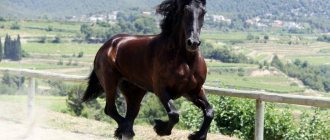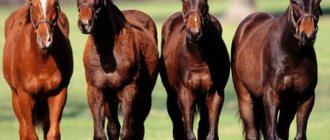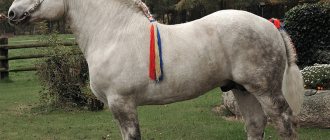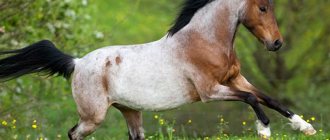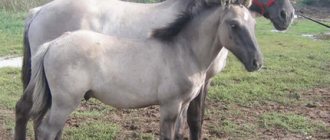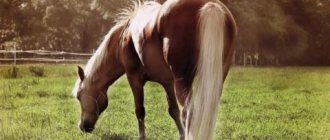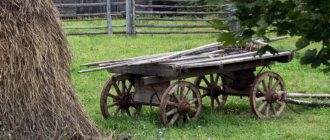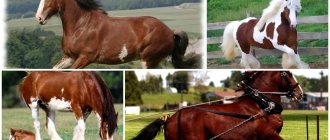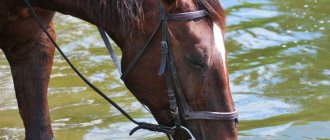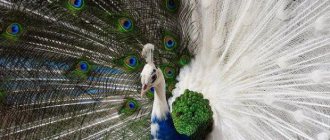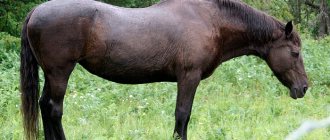A bay horse is often found in Russian folk tales. This kind creature helps the main character solve important problems and achieve his goal. Going with the folklore Ivan in search of the princess along fairy-tale roads, few people in their youth thought about the question of what the word “bay” means. Adults often answered children that they were talking about brown horses, without really delving into the meaning of the name of the color. Few people know where such an unusual word came from in the Russian language, and what kind of bay horses exist in our time.
A bay horse is often found in Russian folk tales.
About the origin of the name
Parents were right when they told their children that a bay mare or stallion was brown in color. If you look at this graceful animal, you can see that almost its entire body is chocolate-colored, but its luxurious mane and bushy tail are darker, almost black. The legs are the same from the hoof to the knee. Scientists believe that the word “bay” is associated with the appearance of the horse.
In the vocabulary of the Old Russian language there once existed the verb “to oppress”; it meant to fan or kindle a fire. A word similar in spelling and meaning can be found in Latin. "Nidor" - smoke, fumes or fumes. The Czechs have the adjective “snědý” - this is how people with dark skin are called. And the ancient Greek “knissa” was used in connection with something fried or even burnt. If you look closely at the bay horse, it will seem that he was in a flame and scorched his tail and mane, and his slender legs practically turned into charred brands. Bay color is the color of something scorched or burnt.
It’s not for nothing that the East invented a legend about these horses. It talks about beautiful light-colored animals. A whole herd of them once approached a lake filled with dragon blood. Overnight the horses turned from snow-white beauties into bay horses, bright as fire and burnt like tree branches. The ancient word suits these animals very well. They couldn’t name their suit more precisely.
Lifestyle and nutrition
A bay horse’s appearance, well-being, and performance directly depend on lifestyle and nutrition. Horses of this color do not require any special housing conditions.
It is enough to follow the following rules:
- the stable should be dry and warm, located on a hill;
- eliminate drafts;
- provide the horse with the necessary amount of drinking and clean water, at the rate of 10 liters per 100 kg of animal;
- care for hooves;
- reduce noise and harsh sounds near the stables to a minimum;
- feed the horse fresh oats and hay in winter, add vitamins, salt and chalk to the diet;
- in summer, provide daily grazing or feed with freshly cut grass.
Why are brown animals so popular?
Horses of the following 4 colors are bred on the globe:
- blacks;
- gray;
- redheads;
- bay.
These are classic purebred colors. The rest of their numerous shades and color combinations are bred by breeders and are called shades. The most common horses have long been bay horses. They were and are loved for their endurance and strength. The bay horse was considered a good helper for the peasant in the field and on the road. In military service, they also preferred bay stallions and mares, considering them to be very docile. But the black horse was considered too hot and uncontrollable. “Singed” horses could travel long distances without getting tired and rarely got sick, unlike their light-colored counterparts.
For modern horse lovers, bay color also serves as an indicator of the strength and health of animals, which is why they are popular in various equestrian clubs. At horse races and dressage competitions, it is the red-and-black beauties that emerge as winners more often than others. But horse breeders value the color of these horses most of all. After all, it makes it possible to breed foals of different shades when crossing.
Lifespan
The lifespan of a horse depends on the conditions of its existence, area and load. Wild individuals rarely live more than 10 years, as they have to fight for survival throughout their lives. Climatic conditions, infections, and predators significantly shorten the life of wild individuals.
Horses live much longer at home, up to 30 years. Breeding stallions have the longest life up to 30 years, as the breeder pays special attention to them. Sports horses live up to 20 years. Even working horses, provided they are well maintained and have the correct alternation of work and rest, can live up to 25 years.
How to tell if a horse is purebred
If you decide to purchase a purebred bay, you should become familiar with the characteristics of the breed. With bay horses, the head, neck, body and legs above the knee are brown. On the “shirt” among the chocolate hairs there are also black hairs. The skin of bays is grey. It can be seen by moving the hairs to the sides. On the animal's face there may be areas lighter or darker than the main color, as well as white spots (star, bald spot). But the eyes are always brown.
The ears, mane, tail and legs below the knee are dark, as if scorched by fire, or black. When purchasing a foal, you may be confused by the light color of its legs. The thing is that the bay color on the legs of horses does not appear immediately, but only after the first molt. As the foal grows older, its legs will darken. With age, a bay mare or horse, like people, turns grey. White “socks” can be seen on the legs of brown animals. Such horses look elegant and are highly valued. An experienced horse breeder will help you choose a handsome, purebred bay. It is worth taking a closer look at other colors of brown horses. Among them there are specimens with a variety of shades from light to the darkest.
Population and reproduction
There are several methods for crossing horses, it all depends on what the breeder’s goals are.
Photo: bishi-teke.com
Purebred - crossing horses of the same breed in order to enhance breeding characteristics.
Linear - crossing animals of the same kind. This method makes it possible to strengthen the characteristics of a particular type of horse.
Horses breed in the summer. Gestation lasts from 287 to 419 days, birth occurs in spring or autumn. Almost always one foal is born, two cubs are very rare.
Light suits
Representatives of the light bay color are golden and brown horses. Light bay animals have brick-colored fur. A darker stripe runs along the back - the “belt”. The areas on the face and near the eyes are lightened. The bay color, which has a dark brown tint, is clearly visible on such parts of the body as the legs below the knee, the head, except for light areas, the tail and mane.
Golden horses have a lighter color, red, the tail and mane are golden brown. But underhaired horses are bright brown; there are light tan marks on the body in the area of the front legs, in the groin, and on the buttocks. On the muzzle there are light areas around the eyes and near the mouth.
Sometimes the mane and tail of hairless horses are bleached. It looks like the horse was dyed blonde. But this indicates that the animal manifested the gene of its ancestors - wild horses.
An unusual bait is the bay deer. The upper part of the horse, its head, neck, back, croup and sides are painted dark brown, as are the tail, mane and legs. The lower part of the muzzle, throat and belly are light brown on a stallion or mare. This transition from dark to light in nature can be observed in deer, which is how the brush got its name.
Artiodactyl habitat
The ancestors of today's horses lived throughout Eurasia and northern Africa. Later in the Ice Age they lived in North America, but became extinct about 10 thousand years ago. Scientists believe that horses are the only genus of the equine family of the artiodactyl order that has survived to this day.
In some regions, you can still find herds of horses living in the wild today. Domesticated species are distributed throughout the world; they are represented by a huge number of breeds that differ in build, size, head shape, color and other characteristics.
The preferred habitat for horses is cool temperate climates with grasslands, steppes and savannas. Some species can live in semi-deserts, as well as among forests and swampy areas. When domesticated, horses can adapt to different places and climates.
Photo gallery
Owners of bay color are widespread in different countries of the world, and the variety of shades is so great that such animals can be the ancestors of all existing breeds. Moreover, now there is no true bay color, but only combined variations.
The story goes that the original horse had a light brown body, as well as completely black hooves and tail. You can get acquainted with the external features of modern animals using a detailed photo gallery.
Famous "bays"
Old Billy
Bay horses are regular participants in various sports competitions and races, they win first places and often become record winners, whose names fit into the “horse” history:
- Thus, the longest-living record holder is a gelding named Billy. While the average horse lives 25 years, he lived a whopping 62 years. And his life was not strewn with roses, all his life from birth to death, he towed a barge along the coast.
- Vulcan is a heavy truck, which back in 1924 was able to carry luggage weighing 29.5 tons.
- The dark bay horse Nearco is the progenitor of many champions who annually win prestigious competitions.
- Picolo Ribot is an Italian horse who has never known what losing is, since he has only winnings in his piggy bank. He managed to reach the finish line, ahead of his rivals by several lengths.
Picolo Ribot
- The best English riding horse that has been officially recognized is Frankel. It was valued at a record $200 million.
- An elegant and beautiful horse, Poetin , with a tragic fate, received from fans the nickname “Ballerina” and the more prosaic nickname “Million Dollar Baby.” She has shone since 2000 at various conformation competitions, where she was always among the favorites, and in competitions the judges rated her gallop, trot and walk very highly, often giving her the maximum score.
Bay horses in art
The crew of Governor Zakhary Korneev
The grace and beauty of this color could not fail to interest people of art - artists, sculptors, directors, poets.
Belarusian sculptor Vladimir Zhbanov gave life to the sculptural composition “Crew of Governor Zakhary Korneev”, installed in Minsk.
Two bay horses harnessed to a phaeton won the love of townspeople and tourists. Copies of this sculpture migrated to Russian cities. They can be found in Tobolsk under the name “A Pair of Horses Harnessed to a Carriage”, in Kursk under the name “Governor’s Carriage” and in the town of Dolgoprudny near Moscow.
Poets also did not stand aside and dedicated lines of poems to these magnificent animals, and the romance “A Pair of Bays” was written based on Apukhtin’s poems, which became a classic.
Cinema and horses are inseparable, especially when it comes to filming films with military, historical, and adventure themes. Bay horses often appear in films - “War and Peace” by Bondarchuk the Father, “The Elusive Avengers” and others.
There is a subgenre in painting - ippic, from the Greek word hippos - horse. Many artists in the 18th and 19th centuries depicted bay horses in their landscapes, battle paintings, and ceremonial portraits.
In these times, the horse played a significant role in human life - it was a means of transportation, a breadwinner and a faithful friend on the battlefield.
Health
The health of a horse and its color, on the contrary, are interconnected. It has been proven that gray horses are more susceptible to the development of solid “blank” tumors (melanosarcomas) and allergic rashes.
Horses of the rare white color often develop hereditary defects. Among them is low fertility, or even infertility. This destroyed the once famous line of white Hanoverian horses, still depicted on the coat of arms of Hanover.
The bay color is not associated with any defects. "Bays" are usually strong and hardy.
Breeds
Cleveland Bay Horse
Every breed has bay representatives, and this is no coincidence. It is popular among breeders and horse breeders.
The Cleveland bay breed stands apart. There are only animals of this color here. They are powerful, chestnut in color. The breed is very old, and was bred in medieval England.
Character
In the popular imagination, there are persistent stereotypes about the connection between a horse’s color and its character. Ravens are considered restive and even aggressive, red horses are considered unbalanced, gray horses are considered good-natured, and the bay horse is a symbol of reliability.
Neither scientific research nor observations of horse breeders confirm such a connection. It happens that in three neighboring stalls there are three bay horses, each with its own character. As de La Guerinière wrote in the Horse Bible, “color is nothing more than a game of nature,” emphasizing that among horses of different colors there are both evil and kind.
The opinion that a horse's character depends on color is not supported from a scientific point of view.
Care
Such horses do not require any special maintenance conditions. The main thing is to equip a warm, dry stable and ensure the complete absence of drafts.
Regular hygiene procedures will help maintain the beauty and health of the animal. You need to clean your horse at least once every 3 days, be sure to wipe it with clean water. It is recommended to inspect the hooves daily to watch for any cracks or cuts.
Horse care
Diet and feeding
The basic rules for feeding any horse are based on the structural features of its digestive system. It is important to know that horses do not have a gallbladder, and the bile produced by the liver cannot process heavy foods. All feed must be exclusively of plant origin, as easily digestible as possible and have a high energy value in order to replenish the energy spent on racing or agricultural work.
Basic feeding rules should be followed:
- To avoid colic, it is important to give your pet rest before and after feeding. The rest time should be at least 1 hour, and preferably 1.5. If you do not follow this regimen, the horse can become seriously ill and even die.
- It is necessary to feed in small portions: from 4 to 8 times a day. Feedings should be regular so that food is better absorbed.
- A horse needs about 40 liters of water per day, and in the summer heat - up to 80. It is important to ensure that the water is not too cold, especially if the horse is sweating. You can water your horse before or after feeding.
Horse feed
The diet should include the following plant foods:
- Grass. In summer it serves as the main food in combination with concentrates. Fresh grass is very nutritious, contains protein, sugar, and essential vitamins.
- Hay and straw. It is necessary to monitor the quality of the hay: it must be properly dried and free of mold. Improperly stored dry herb can be hazardous to health. Straw is low in calories and is used for bedding. This roughage should make up about 40% of the diet. It must be given all year.
- Haylage. It differs from regular hay in that the grass is dried in tightly packed bales. This feed contains more water than regular hay.
- Corn. For example, oats, which are easily digestible.
- Silage. Such food must be prepared correctly, otherwise, if there are problems with fermentation, it can have a bad effect on digestion.
- Bran. As a rule, they are consumed in the form of porridges.
- Vegetables and fruits. This is a healthy delicacy rich in vitamins.
Now even beginners have figured out which horse is called a bay. A fiery horse with a developing coal-black mane will not leave anyone indifferent. Moreover, they can be found both at elite horse racing and in agriculture.
0 0 votes
Article rating
